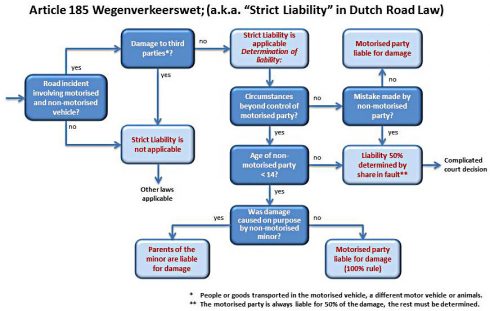A commenter on Facebook made a statement which is often heard in the USA:
“A Dutch lady said they have so few hurt because drivers are guilty unless they can prove they weren’t.”
Well, this doesn’t quite amount to fake news as such. I don’t expect that there was any intention to deceive, but it is hearsay.
The actual situation with liability in the Netherlands is more complicated, as described in the flow chart below, from a Bicycle Dutch blog post — which cites the Dutch traffic law, in case you would like to take your exploration of the topic further. You may click on the image to enlarge it.
I’m simplifying somewhat, but Dutch strict liability works much like no-fault auto insurance in the USA, and applies only to compensation for injuries, not to penalties.


In many west European countries insurance subrogates all damages, so the assignment of liability is really an administration problem. In other words, no matter how much damages are incurred by the cyclist (or, for matter, the motorist is a multi-car crash), he or she has no recourse to litigation. First, the motorist’s insurance pays out, then if the cyclist is badly harmed, he or she turns to their own social security insurance and protections (disability, medical, etc.) The “to be determined” box is probably a social security disability panel or insurance arbitration board.
In most European countries, civil litigation is a big, time consuming, expensive process, so they try to make a weave of private insurance and social security do the job. That being the case, a legal algorithm like the one you show is not really that weird. Its mostly a closed system in which the state ultimately picks up most of the burden in severe damage cases, so they try to incorporate it into their system of sticks and carrots to (as the case may be) encourage or coerce social cooperation. Like it not, that’s the West European system, and I personally think almost anything is better than the American civil litigation system.
Thanks for your observations. Having served as a consultant and expert witness in bicycling cases since 1982, I can agree with your low rating of the American civil litigation system as it works for individuals: it is inefficient, and capricious if it reaches the courtroom. I have testified in cases in which poor evidence-gathering, irrelevant technicalities, slick lawyering and/or jury bias denied injured bicyclists compensation which they needed and deserved. That is aside from the issue that the framework of the discussion is adversarial, with insurers’ goal being to not pay out, regardless of need, and that the social safety net has major gaps in both the private an public sector. On the other hand though, the American system is effective at holding powerful entities in check against systemic abuses where, as described in an article by Dr. David Gordon Wilson, the European system — in the U.K at least, as he describes it, is not. Name your poison!
The problem in the U.S. is that if one is to have full access to the benefits of liability insurance, a lawyer is needed, and that usually entails a contingency fee of 33%. If the damages are much higher, and litigation against the tortfeasor is required, the fees for an honest lawyer are 40%, but many are not, failing to include costs and contracted fees (experts, investigators, researchers; recorders, videographers, often working through wholly-owned subsidarys of the law firm) within that 40%, so the split ends up being more like 50/50. (And if the fees go through subsidiary firms, much higher.)
In the the type mega-litigation David Gordon Wilson is talking about, the fees and costs actually outweigh the damages. The same is true in most class action suits.
Then comes the problem (in the case of the small guy) of collection. U. S. law is very friendly towards defendant-creditors who work to shield assets from collection. I have been working on one modest defendant creditor who started 14 years ago owing my client $2,500 and now owes $114,000. Will I get it? Like I told him in court – yes, when he dies, and he has to die. And I check every day.
Well, then, I hope that you outlive that defendant!
Pingback: BikeSnob’s BS gets published in Outhouse… again – Biking in the Middle
Pingback: Martine Powers talk, October 17, 2013 – bostonbiker